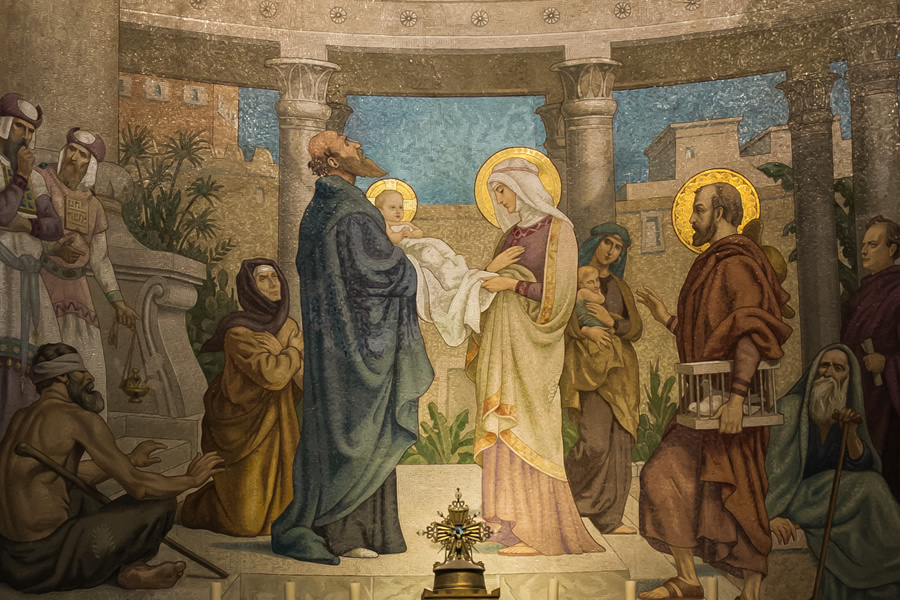
The Presentation of the Lord - Candlemas
by Rev. Gabriel Baltes, O.S.B. | 02/02/2025 | A Message from Our PastorDear Parishioners,
With today’s feast of The Presentation of the Lord, the church brings the Christmas Season to what was its official traditional end prior to the liturgical reforms of the Second Vatican Council. One can still see traces of this understanding in Rome and parts of Europe where Christmas Nativity Scenes and other decorations are kept in place until this day. Here at St. Joan of Arc, we honor that traditional closure by keeping most of our church decorations up until this day.
This feast of the Lord’s Presentation commemorates the biblical event when, forty days after his birth, the parents of Jesus brought him to the temple in Jerusalem and presented him to God as their firstborn son. This was the common practice among the people of Israel dating back to the time of Moses when the firstborn male of both humans and animals were consecrated to God and recognized as having a privileged status within the family. We read in Luke’s Gospel that when Mary and Joseph brought Jesus to the temple on this occasion, they were met by Simeon the priest who, throughout his life, eagerly awaited the coming of the Messiah and hoped that he would not die until he encountered him. His hope was fulfilled when Jesus’ parents placed their child in his aged arms and he lifted this child in joyful gratitude and prayed the following text that came to be called “Simeon’s Canticle”:
Now, Master, you let your servant go in peace. You have fulfilled your promise. My own eyes have seen your salvation, which you have prepared in the sight of all peoples. A light to bring the Gentiles from darkness; the glory of your people Israel. (Luke 2:29–32)
This prayer, found only in the Gospel of Luke, is so revered in Christian worship that it is offered each day in the church’s official Night Prayer (aka Compline) that is sung or recited by all priests and religious.
Like so many feast days within Catholicism, over time, The Presentation of the Lord got layered with multiple meanings and ritual elements. With the focus on light found in Simeon’s Canticle, this became the day when the church formally blessed all the candles that it would use in its sacred rites throughout the upcoming year. Later, a candlelight procession throughout the town or village was incorporated into the celebration of this day to demonstrate the Christian conviction that the Light of Christ has come into the world and will always be victorious over the darkness which, by this time of year, had become especially oppressive as winter lingered on.
In Ireland, this feast, (that also came to be called “Candlemas Day”) took on special significance given its proximity to the commemoration of St. Brigid of February 1. Before Christianity, Brigid was one of the ancient Celtic goddesses. After Christianity, she was incorporated into the church’s collection of saints. St. Brigid was said to watch over animals and was prayed to by the people of Ireland for the protection of their sheep and cattle. She was also invoked as a guardian of fire and was a special patron for women whose responsibility it was to keep alive the fire in the household hearth.
As one can see, the liturgical and cultural richness of February 2 increased in a wide variety of ways throughout the Christian centuries and eventually came to be recognized as a mid-winter transitional celebration that bid farewell to the darkness of the winter as it anticipated the coming of spring and the gradual increase of light. We do well to use this day as an occasion to pray for greater light within our world and within our lives. Even though times and seasons of darkness can be enriching and growthful, there is something deep within the human person that craves the light. It would be most fitting for households to light blessed candles on this day and recognize, not only the light they offer, but to realize that each of us, baptized in Christ, is a light-bearing torch called to brighten the world by the way we live. The following poem, written by the Trappist monk Thomas Merton, reflects on this symbolism that he would have experienced in the monastic ritual at Gethsemane Abbey in Kentucky.
Candlemas Procession
Lumen
Ad revelationem gentium.
Look kindly, Jesus, where we come,
New Simeons, to kindle,
Each at Your infant sacrifice his own life’s candle.
And when Your flame turns into many tongues,
See how the One is multiplied, among us, hundreds!
And goes among the humble, and consoles our sinful kindred.
It is for this we come,
And, kneeling, each receive one flame:
Ad revelationem gentium.
Our lives, like candles, spell this simple symbol:
Weep like our bodily life, sweet work of bees,
Sweeten the world, with your slow sacrifice.
And this shall be our praise:
That by our glad expense, our Father’s will
Burned and consumed us for a parable.
Nor burn we now with brown and smoky flames, but bright
Until our sacrifice is done,
(By which not we, but You are known)
And then, returning to our Father, one by one,
Give back our lives like wise and waxen lights.
Blessings,
Fr. Gabriel, OSB
BACK TO LIST